lock FIAT DUCATO BASE CAMPER 2015 Owner handbook (in English)
[x] Cancel search | Manufacturer: FIAT, Model Year: 2015, Model line: DUCATO BASE CAMPER, Model: FIAT DUCATO BASE CAMPER 2015Pages: 367, PDF Size: 19.73 MB
Page 218 of 367
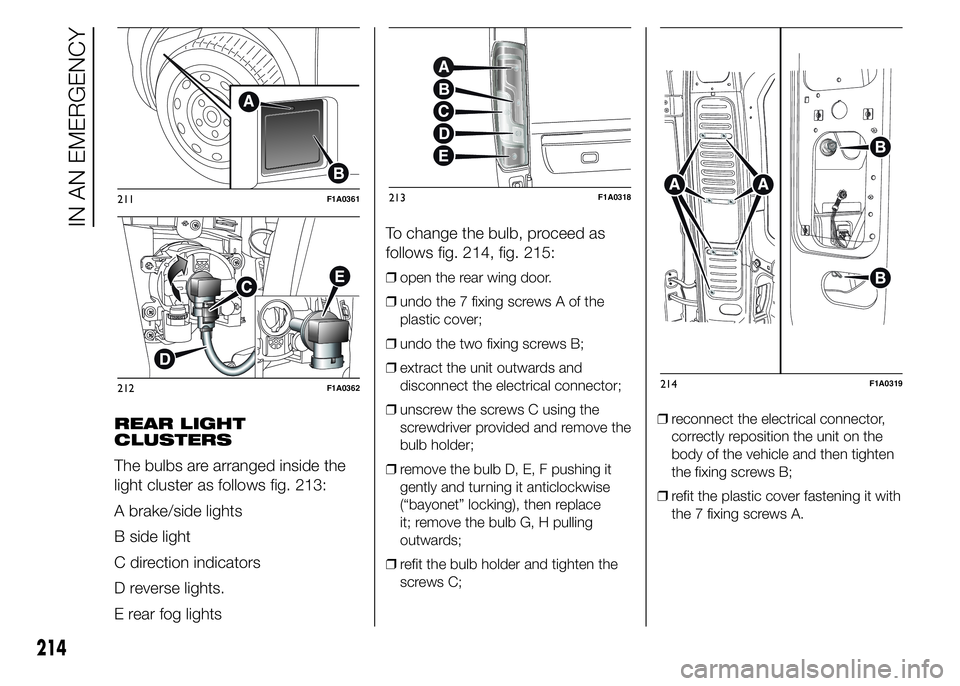
REAR LIGHT
CLUSTERS
The bulbs are arranged inside the
light cluster as follows fig. 213:
A brake/side lights
B side light
C direction indicators
D reverse lights.
E rear fog lightsTo change the bulb, proceed as
follows fig. 214, fig. 215:
❒open the rear wing door.
❒undo the 7 fixing screws A of the
plastic cover;
❒undo the two fixing screws B;
❒extract the unit outwards and
disconnect the electrical connector;
❒unscrew the screws C using the
screwdriver provided and remove the
bulb holder;
❒remove the bulb D, E, F pushing it
gently and turning it anticlockwise
(“bayonet” locking), then replace
it; remove the bulb G, H pulling
outwards;
❒refit the bulb holder and tighten the
screws C;❒reconnect the electrical connector,
correctly reposition the unit on the
body of the vehicle and then tighten
the fixing screws B;
❒refit the plastic cover fastening it with
the 7 fixing screws A.
211F1A0361
212F1A0362
213F1A0318
214F1A0319
214
IN AN EMERGENCY
Page 220 of 367
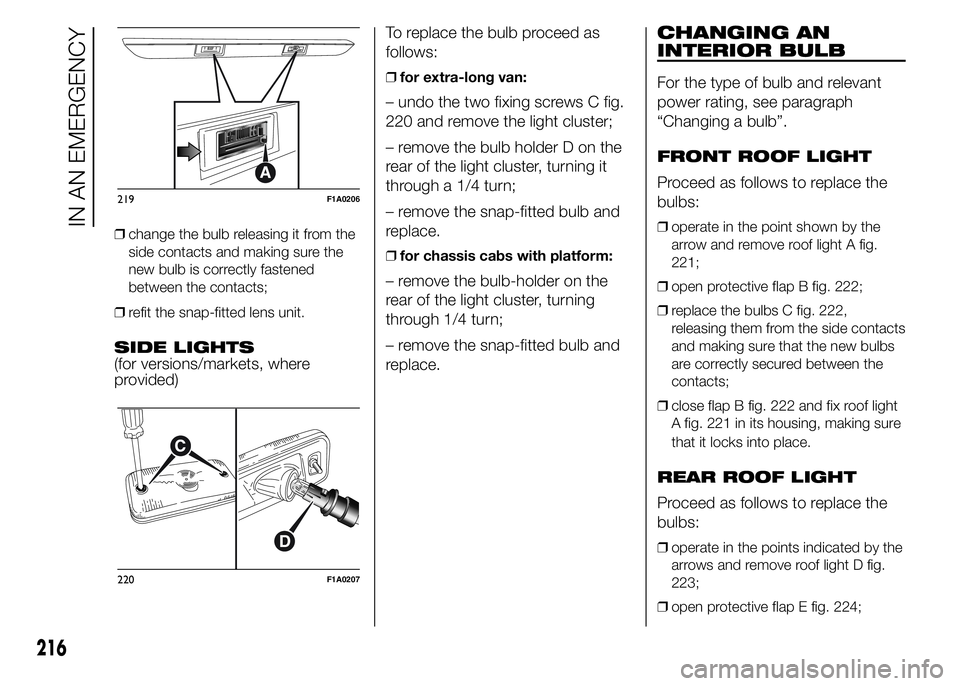
❒change the bulb releasing it from the
side contacts and making sure the
new bulb is correctly fastened
between the contacts;
❒refit the snap-fitted lens unit.
SIDE LIGHTS
(for versions/markets, where
provided)To replace the bulb proceed as
follows:
❒for extra-long van:
– undo the two fixing screws C fig.
220 and remove the light cluster;
– remove the bulb holder D on the
rear of the light cluster, turning it
through a 1/4 turn;
– remove the snap-fitted bulb and
replace.
❒for chassis cabs with platform:
– remove the bulb-holder on the
rear of the light cluster, turning
through 1/4 turn;
– remove the snap-fitted bulb and
replace.
CHANGING AN
INTERIOR BULB
For the type of bulb and relevant
power rating, see paragraph
“Changing a bulb”.
FRONT ROOF LIGHT
Proceed as follows to replace the
bulbs:
❒operate in the point shown by the
arrow and remove roof light A fig.
221;
❒open protective flap B fig. 222;
❒replace the bulbs C fig. 222,
releasing them from the side contacts
and making sure that the new bulbs
are correctly secured between the
contacts;
❒close flap B fig. 222 and fix roof light
A fig. 221 in its housing, making sure
that it locks into place.
REAR ROOF LIGHT
Proceed as follows to replace the
bulbs:
❒operate in the points indicated by the
arrows and remove roof light D fig.
223;
❒open protective flap E fig. 224;
219F1A0206
220F1A0207
216
IN AN EMERGENCY
Page 221 of 367
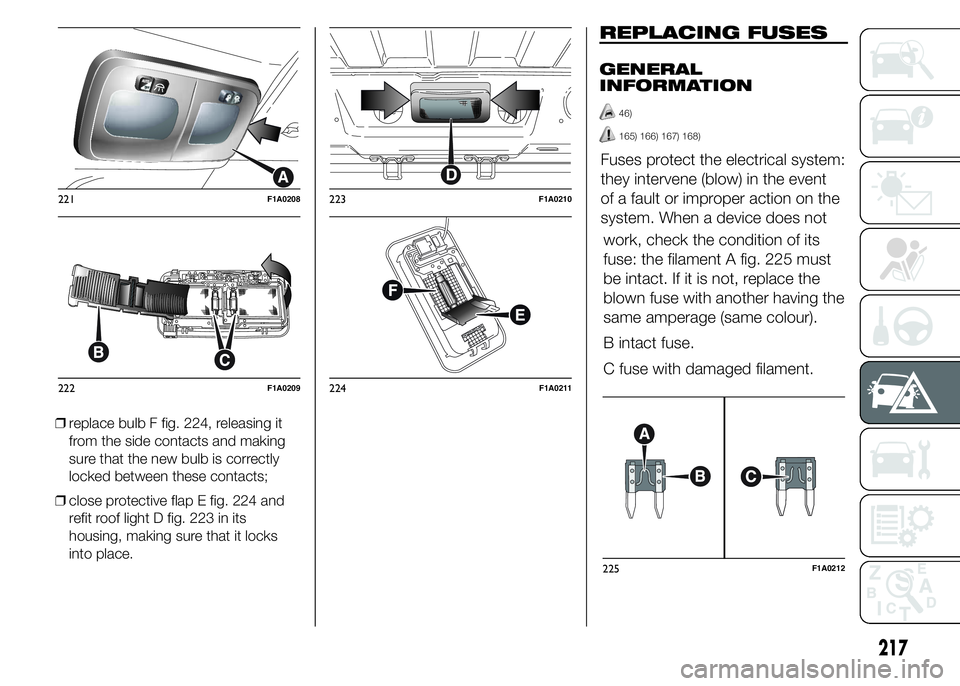
❒replace bulb F fig. 224, releasing it
from the side contacts and making
sure that the new bulb is correctly
locked between these contacts;
❒close protective flap E fig. 224 and
refit roof light D fig. 223 in its
housing, making sure that it locks
into place.
REPLACING FUSES
GENERAL
INFORMATION
46)
165) 166) 167) 168)
Fuses protect the electrical system:
they intervene (blow) in the event
of a fault or improper action on the
system. When a device does not
work, check the condition of its
fuse: the filament A fig. 225 must
be intact. If it is not, replace the
blown fuse with another having the
same amperage (same colour).
B intact fuse.
C fuse with damaged filament.
221F1A0208
222F1A0209
223F1A0210
224F1A0211
225F1A0212
217
Page 223 of 367
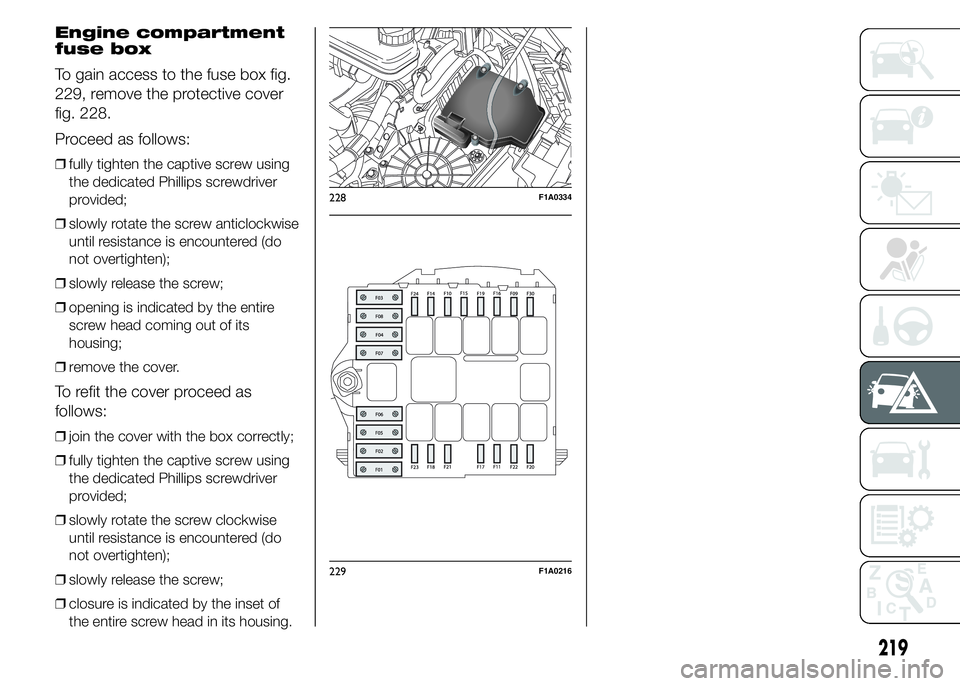
Engine compartment
fuse box
To gain access to the fuse box fig.
229, remove the protective cover
fig. 228.
Proceed as follows:
❒fully tighten the captive screw using
the dedicated Phillips screwdriver
provided;
❒slowly rotate the screw anticlockwise
until resistance is encountered (do
not overtighten);
❒slowly release the screw;
❒opening is indicated by the entire
screw head coming out of its
housing;
❒remove the cover.
To refit the cover proceed as
follows:
❒join the cover with the box correctly;
❒fully tighten the captive screw using
the dedicated Phillips screwdriver
provided;
❒slowly rotate the screw clockwise
until resistance is encountered (do
not overtighten);
❒slowly release the screw;
❒closure is indicated by the inset of
the entire screw head in its housing.
228F1A0334
229F1A0216
219
Page 225 of 367

Dashboard fuse box
fig. 226 - fig. 227
DEVICE PROTECTED FUSE AMPERE
Right dipped beam headlight F12 7,5
Left dipped headlight F13 7,5
Engine compartment control unit relay, dashboard control unit relay (+key) F31 5
Lighting of roof lights in the passenger compartment (+battery) F32 7,5
Battery monitoring sensor for Start&Stop versions (+battery) F33 7,5
Minibus interior lights (emergency) F34 7,5
Radio, climate control, alarm, tachograph, battery disconnecting control unit,
Webasto timer (+battery)F36 10
Brake light control (main), third brake light, instrument panel (+key) F37 7,5
Door lock (+battery) F38 20
Windscreen wiper (+key) F43 20
Driver's side electric window F47 20
Passenger side electric window F48 20
Parking sensor control unit, radio, steering wheel controls, central control panel,
left control panel, auxiliary panel, battery disconnecting control unit (+key)F49 5
Climate control, power steering control unit, reverse lights, diesel filter water
sensor, flow meter, tachograph (+key)F51 5
Instrument panel (+battery) F53 7,5
AbsentF89 -
221
Page 231 of 367
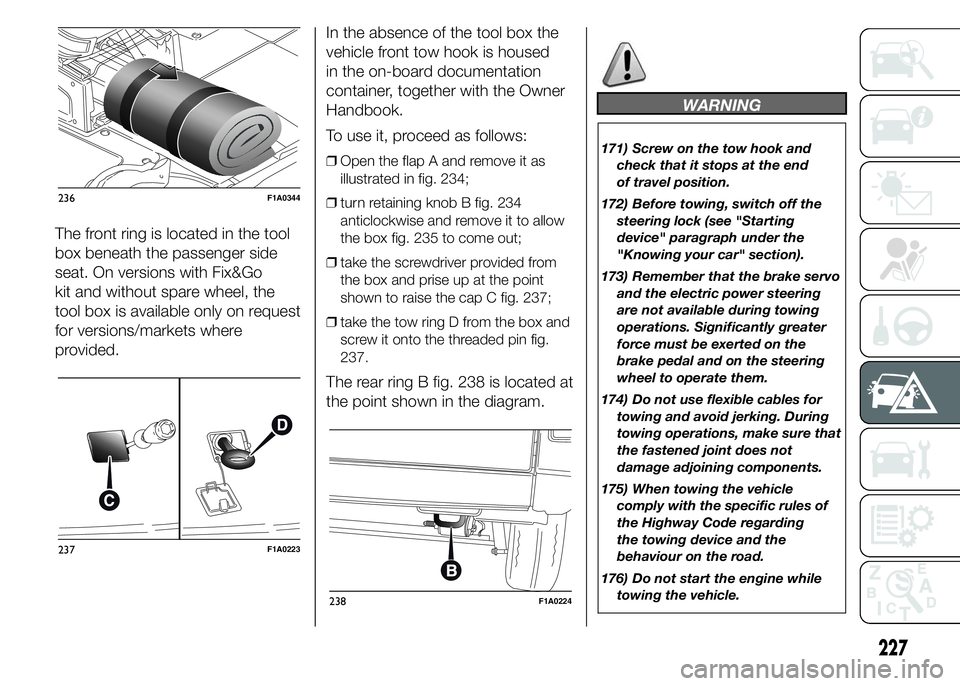
The front ring is located in the tool
box beneath the passenger side
seat. On versions with Fix&Go
kit and without spare wheel, the
tool box is available only on request
for versions/markets where
provided.In the absence of the tool box the
vehicle front tow hook is housed
in the on-board documentation
container, together with the Owner
Handbook.
To use it, proceed as follows:
❒Open the flap A and remove it as
illustrated in fig. 234;
❒turn retaining knob B fig. 234
anticlockwise and remove it to allow
the box fig. 235 to come out;
❒take the screwdriver provided from
the box and prise up at the point
shown to raise the cap C fig. 237;
❒take the tow ring D from the box and
screw it onto the threaded pin fig.
237.
The rear ring B fig. 238 is located at
the point shown in the diagram.
WARNING
171) Screw on the tow hook and
check that it stops at the end
of travel position.
172) Before towing, switch off the
steering lock (see "Starting
device" paragraph under the
"Knowing your car" section).
173) Remember that the brake servo
and the electric power steering
are not available during towing
operations. Significantly greater
force must be exerted on the
brake pedal and on the steering
wheel to operate them.
174) Do not use flexible cables for
towing and avoid jerking. During
towing operations, make sure that
the fastened joint does not
damage adjoining components.
175) When towing the vehicle
comply with the specific rules of
the Highway Code regarding
the towing device and the
behaviour on the road.
176) Do not start the engine while
towing the vehicle.
236F1A0344
237F1A0223
238F1A0224
227
Page 235 of 367
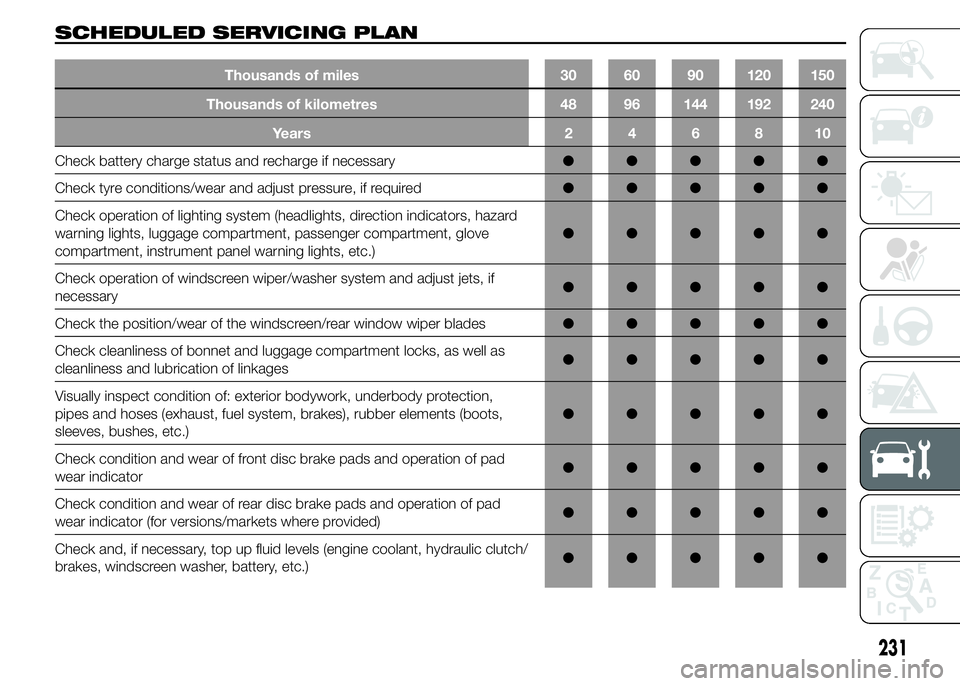
SCHEDULED SERVICING PLAN
Thousands of miles 30 60 90 120 150
Thousands of kilometres 48 96 144 192 240
Years246810
Check battery charge status and recharge if necessary●●●●●
Check tyre conditions/wear and adjust pressure, if required●●●●●
Check operation of lighting system (headlights, direction indicators, hazard
warning lights, luggage compartment, passenger compartment, glove
compartment, instrument panel warning lights, etc.)●●●●●
Check operation of windscreen wiper/washer system and adjust jets, if
necessary●●●●●
Check the position/wear of the windscreen/rear window wiper blades●●●●●
Check cleanliness of bonnet and luggage compartment locks, as well as
cleanliness and lubrication of linkages●●●●●
Visually inspect condition of: exterior bodywork, underbody protection,
pipes and hoses (exhaust, fuel system, brakes), rubber elements (boots,
sleeves, bushes, etc.)●●●●●
Check condition and wear of front disc brake pads and operation of pad
wear indicator●●●●●
Check condition and wear of rear disc brake pads and operation of pad
wear indicator (for versions/markets where provided)●●●●●
Check and, if necessary, top up fluid levels (engine coolant, hydraulic clutch/
brakes, windscreen washer, battery, etc.)●●●●●
231
Page 238 of 367
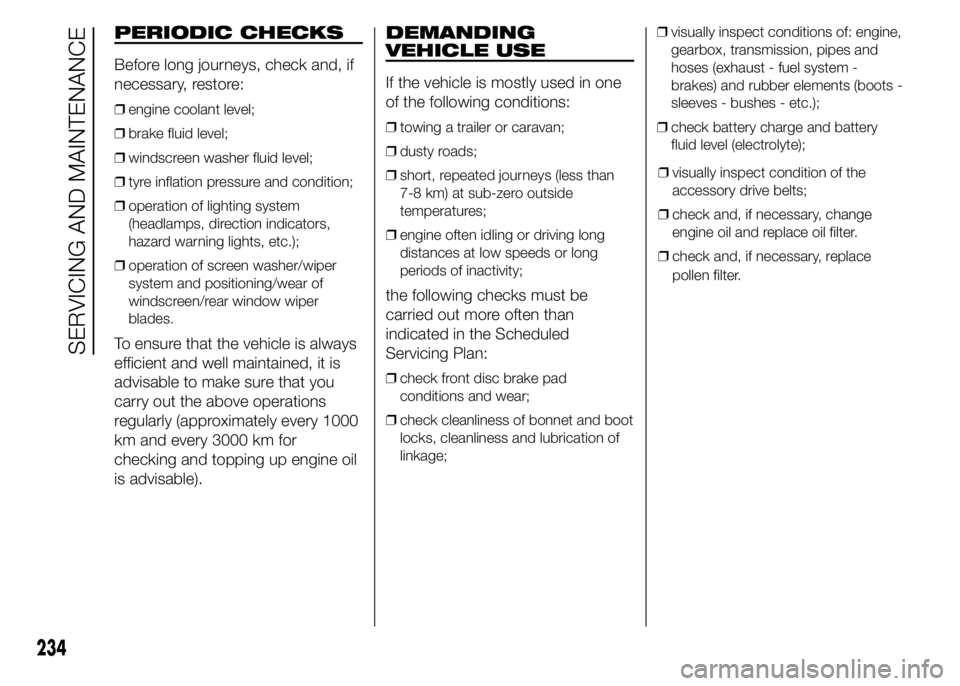
PERIODIC CHECKS
Before long journeys, check and, if
necessary, restore:
❒engine coolant level;
❒brake fluid level;
❒windscreen washer fluid level;
❒tyre inflation pressure and condition;
❒operation of lighting system
(headlamps, direction indicators,
hazard warning lights, etc.);
❒operation of screen washer/wiper
system and positioning/wear of
windscreen/rear window wiper
blades.
To ensure that the vehicle is always
efficient and well maintained, it is
advisable to make sure that you
carry out the above operations
regularly (approximately every 1000
km and every 3000 km for
checking and topping up engine oil
is advisable).
DEMANDING
VEHICLE USE
If the vehicle is mostly used in one
of the following conditions:
❒towing a trailer or caravan;
❒dusty roads;
❒short, repeated journeys (less than
7-8 km) at sub-zero outside
temperatures;
❒engine often idling or driving long
distances at low speeds or long
periods of inactivity;
the following checks must be
carried out more often than
indicated in the Scheduled
Servicing Plan:
❒check front disc brake pad
conditions and wear;
❒check cleanliness of bonnet and boot
locks, cleanliness and lubrication of
linkage;❒visually inspect conditions of: engine,
gearbox, transmission, pipes and
hoses (exhaust - fuel system -
brakes) and rubber elements (boots -
sleeves - bushes - etc.);
❒check battery charge and battery
fluid level (electrolyte);
❒visually inspect condition of the
accessory drive belts;
❒check and, if necessary, change
engine oil and replace oil filter.
❒check and, if necessary, replace
pollen filter.
234
SERVICING AND MAINTENANCE
Page 242 of 367
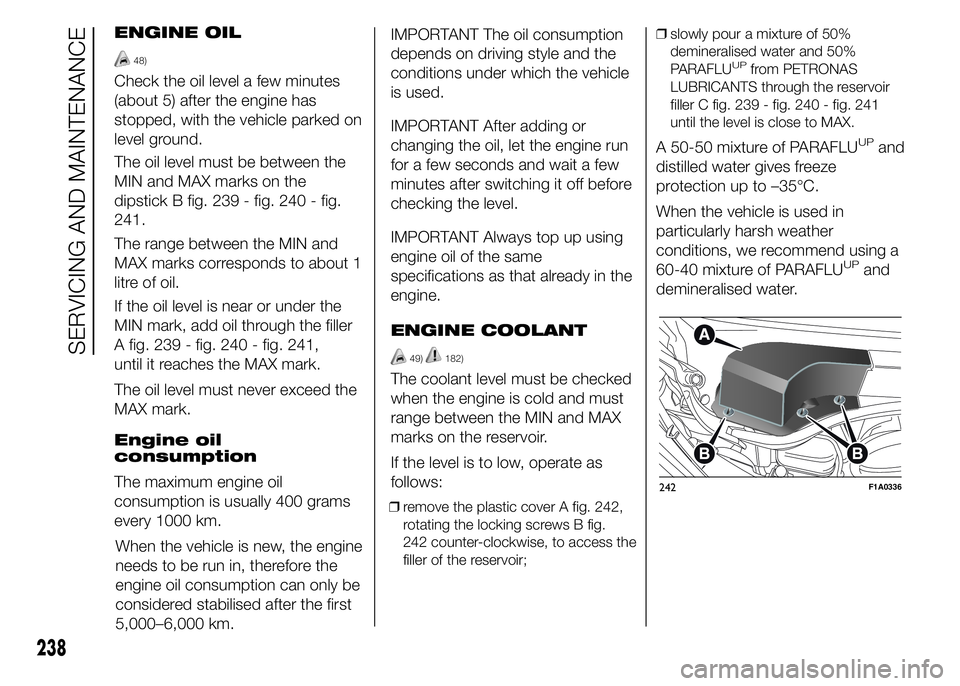
ENGINE OIL
48)
Check the oil level a few minutes
(about 5) after the engine has
stopped, with the vehicle parked on
level ground.
The oil level must be between the
MIN and MAX marks on the
dipstick B fig. 239 - fig. 240 - fig.
241.
The range between the MIN and
MAX marks corresponds to about 1
litre of oil.
If the oil level is near or under the
MIN mark, add oil through the filler
A fig. 239 - fig. 240 - fig. 241,
until it reaches the MAX mark.
The oil level must never exceed the
MAX mark.
Engine oil
consumption
The maximum engine oil
consumption is usually 400 grams
every 1000 km.
When the vehicle is new, the engine
needs to be run in, therefore the
engine oil consumption can only be
considered stabilised after the first
5,000–6,000 km.IMPORTANT The oil consumption
depends on driving style and the
conditions under which the vehicle
is used.
IMPORTANT After adding or
changing the oil, let the engine run
for a few seconds and wait a few
minutes after switching it off before
checking the level.
IMPORTANT Always top up using
engine oil of the same
specifications as that already in the
engine.
ENGINE COOLANT
49)182)
The coolant level must be checked
when the engine is cold and must
range between the MIN and MAX
marks on the reservoir.
If the level is to low, operate as
follows:
❒remove the plastic cover A fig. 242,
rotating the locking screws B fig.
242 counter-clockwise, to access the
filler of the reservoir;❒slowly pour a mixture of 50%
demineralised water and 50%
PARAFLU
UPfrom PETRONAS
LUBRICANTS through the reservoir
filler C fig. 239 - fig. 240 - fig. 241
until the level is close to MAX.
A 50-50 mixture of PARAFLUUPand
distilled water gives freeze
protection up to –35°C.
When the vehicle is used in
particularly harsh weather
conditions, we recommend using a
60-40 mixture of PARAFLU
UPand
demineralised water.
242F1A0336
238
SERVICING AND MAINTENANCE
Page 243 of 367
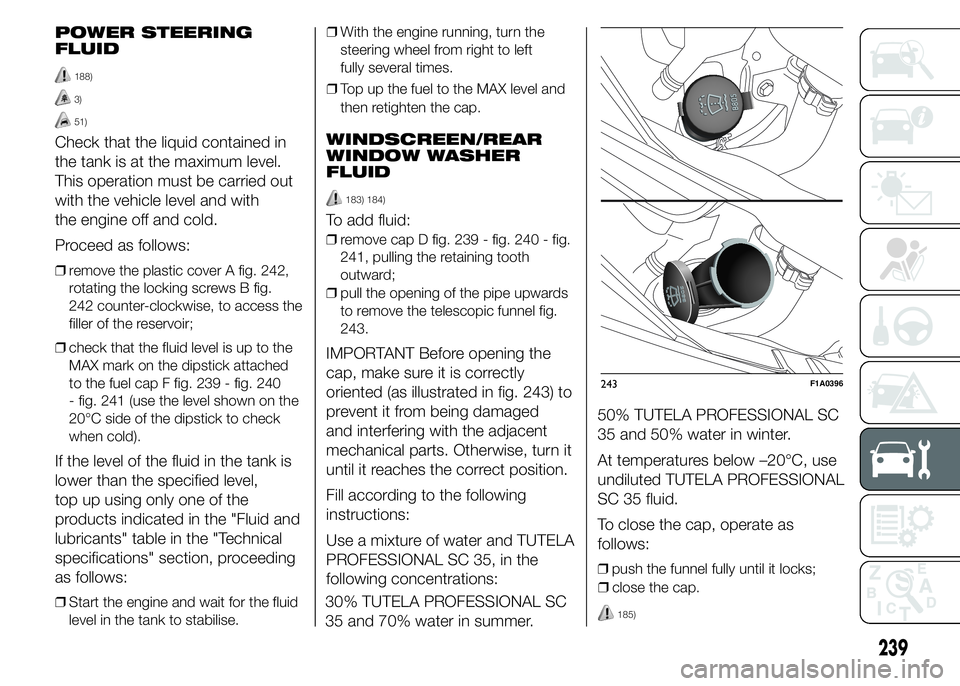
POWER STEERING
FLUID
188)
3)
51)
Check that the liquid contained in
the tank is at the maximum level.
This operation must be carried out
with the vehicle level and with
the engine off and cold.
Proceed as follows:
❒remove the plastic cover A fig. 242,
rotating the locking screws B fig.
242 counter-clockwise, to access the
filler of the reservoir;
❒check that the fluid level is up to the
MAX mark on the dipstick attached
to the fuel cap F fig. 239 - fig. 240
- fig. 241 (use the level shown on the
20°C side of the dipstick to check
when cold).
If the level of the fluid in the tank is
lower than the specified level,
top up using only one of the
products indicated in the "Fluid and
lubricants" table in the "Technical
specifications" section, proceeding
as follows:
❒Start the engine and wait for the fluid
level in the tank to stabilise.❒With the engine running, turn the
steering wheel from right to left
fully several times.
❒Top up the fuel to the MAX level and
then retighten the cap.
WINDSCREEN/REAR
WINDOW WASHER
FLUID
183) 184)
To add fluid:
❒remove cap D fig. 239 - fig. 240 - fig.
241, pulling the retaining tooth
outward;
❒pull the opening of the pipe upwards
to remove the telescopic funnel fig.
243.
IMPORTANT Before opening the
cap, make sure it is correctly
oriented (as illustrated in fig. 243) to
prevent it from being damaged
and interfering with the adjacent
mechanical parts. Otherwise, turn it
until it reaches the correct position.
Fill according to the following
instructions:
Use a mixture of water and TUTELA
PROFESSIONAL SC 35, in the
following concentrations:
30% TUTELA PROFESSIONAL SC
35 and 70% water in summer.50% TUTELA PROFESSIONAL SC
35 and 50% water in winter.
At temperatures below –20°C, use
undiluted TUTELA PROFESSIONAL
SC 35 fluid.
To close the cap, operate as
follows:
❒push the funnel fully until it locks;
243F1A0396
239
❒close the cap.
185)